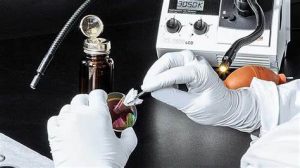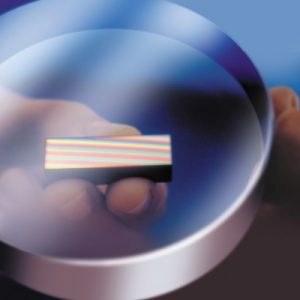
Optical Surface Specifications
The surface specifications of optical windows affect the optical performance and must be considered when selecting or specifying a window. It is important to make sure your optical window has the appropriate specifications with respect to tightness to meet your application requirements, but over-tolerancing the window will unnecessarily increase the cost.
Surface Quality
The surface quality of an optical window is an evaluation of surface imperfections that may be caused during manufacturing or handling. These defects typically cause small reductions in throughput and small increases in scattered light, which have little to no adverse effect on the overall system performance in most imaging or light gathering applications. However, some surfaces are more sensitive to these defects, such as surfaces at image planes, because surface defects are in focus. Windows with high power levels are also sensitive to surface defects because they can cause increased absorption of energy and damage the window.
Surface quality is often described by the scratch-dig specification in the U.S. Standard MIL-PRF-13830B. The scratch designation is determined by comparing the scratches on a surface to a set of standard scratches under controlled lighting conditions. This is not a direct measurement of the scratch dimensions themselves. On the other hand, the dig designation directly relates to the size of the dig. The dig designation is calculated by taking the diameter of the dig in microns and dividing it by 10.

Scratch-Dig Description
The table below shows scratch-dig specifications needed for a variety of applications.
| Scratch-Dig | Description |
| 80-50 or 40-40 | These are the most commonly used surface quality specifications for commercial grade applications and cases where surface quality is not critical. Windows for imaging systems typically fall in this category. These provide the most cost-effective window options. |
| 40-20 | Used for precision applications where surface quality is important. This is a common specification for low to medium powered laser systems and smaller optics. There is some premium over lower surface-quality windows. |
| 20-10 or 10-5 | These specifications are used almost exclusively for high power laser systems and very high precision systems where surface quality is critical. There is typically a significant cost premium associated with these surface quality specifications. |
Surface Flatness
Surface flatness measures the deviation of the window from a perfectly flat surface. The surface flatness of a test piece can be measured using an optical flat, which is a highly precise flat reference surface. When the surface of the test window is placed against the optical flat, fringes appear whose shape dictates the surface flatness of the window under inspection. The window’s surface is at least as flat as the reference flat if the fringes are evenly spaced, straight, and parallel. If the fringes are curved, the flatness error is indicated by the number of fringes between two imaginary lines: one tangent to the center of a fringe and one through the ends of that same fringe. Deviations in flatness are typically measured in values of waves (λ), or multiples of the testing light source’s wavelength. Every fringe corresponds to half of a wave. 1λ flatness can be used for typical applications, but high precision applications such as high power laser systems require flatness values down to λ/20.

Surface Flatness Description
Surface flatness is an increasingly important when using a window at a viewing angle besides normal incidence. The below table shows surface flatness specifications needed for varying applications
| Surface Flatness | Description |
| ≥1λ | Commonly used for commercial grade applications and in cases where surface flatness is not critical. ≥1λ surface flatness is the most cost-effective window option. |
| λ/4 | Used for precision applications where surface quality is important. This is a common specification for low to medium powered laser systems and smaller optics. There is some premium over lower surface-quality windows. |
| ≤λ/10 | Used for high power laser systems and highly precise imaging systems. There is typically a significant cost premium associated with surface flatness ≤λ/10. |
Transmitted Wavefront Error
Surface errors, refractive index inhomogeneity, and stress on the window can induce transmitted wavefront errors. This distortion of the transmitted wavefront causes degradation of image quality in image-forming systems and other performance losses in non-imaging systems. Transmitted wavefront error can be reduced by properly mounting the window and avoiding putting unnecessary stress on it. Transmitted wavefront error, along with surface flatness, describes the overall quality and surface characteristics of the window.